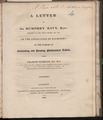Charles Babbage
Sir Charles Babbage (26 December 1791 – 18 October 1871) was an English mathematician, analytical philosopher, mechanical engineer and computer scientist. He was the first person to invent the idea of a computer that could be programmed. Unfinished parts of his mechanisms are on display in the London Science Museum.
Charles Babbage | |
|---|---|
 Charles Babbage | |
| Born | 26 December 1791 London (likely Southwark) |
| Died | 18 October 1871 (aged 79) Marylebone, London, UK |
| Nationality | English |
| Citizenship | British |
| Alma mater | Peterhouse, Cambridge |
| Known for | Difference engine |
| Scientific career | |
| Fields | Mathematics, engineering, political economy, computer science |
| Institutions | Trinity College, Cambridge |
| Signature | |
Charles Babbage was born in England, at 44 Crosby Row, Walworth Road, London. Babbage's father, Benjamin Babbage, was a banker in London who owned the Bitton Estate in Teignmouth. His mother was Betsy Plumleigh Babbage. In 1808, the Babbage family moved into the old Rowdens house in East Teignmouth.
His Brain is also on display in the Science Museum in London.
Works
Babbage worked and wrote on many ideas of science, engineering and mathematics, but he is most famous for two machines he started and never finished. His Difference Engine would have been a much better calculator than any made before then. His Analytical Engine would have been the first real computer.
Knowing that there were many errors in the calculation of mathematical tables, Babbage wanted to find a way to calculate them mechanically, removing errors made by humans. Three different factors seem to have influenced him: a dislike of untidiness; his experience working on logarithmic tables and differential calculus; and work on calculating machines already done by Wilhelm Schickard, Blaise Pascal, and Gottfried Leibniz. He first talked about the principles of a calculating engine in a letter to Sir Humphrey Davy in 1822.
Babbage's engines were among the first mechanical computers. His engines were not actually completed because he did not have enough money. Babbage realized that a machine could do the work better and more reliably than a human being. Babbage controlled building of some steam-powered machines that more or less did their job; calculations could be mechanized to an extent. Although Babbage's machines were large machines they were organized in a way similar to modern computer architecture. The data and program memory were separated, operation was instruction based, control unit could make conditional jumps and the machine had a separate I/O unit. Ada Lovelace studied how to program them.
Charles Babbage Media
A portion of the difference engine
Plate from the Ninth Bridgewater Treatise, showing a parametric family of algebraic curves acquiring isolated real points
Related pages
Other websites
- Charles Babbage -Citizendium









